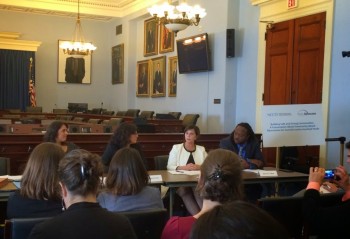Building Safe & Strong Communities

This month on Capitol Hill, National experts came together to discuss community-based alternatives to incarceration that improve public safety and support youth. The panelist all had one definite thing in common: each panelist believes in providing cost-effective, community-based alternatives to institutional placement.
The expert panelists included Judge Denise Navarre Cubbon, Lucas County Juvenile Court, Lucas County, Ohio, Shaena Fazal, National Policy Director, Youth Advocate Programs, Dr. Angela Irvine, Director of Research-Oakland, National Council on Crime and Delinquency, and Steven L. Gates, Program Director, Youth Advocate Programs, Chicago, IL.
 Representative Tony Cardenas (D-CA) and Representative David Reichert (R-MN) are co-chairs for the new, Crime Prevention and Youth Development Caucus. The caucus works toward smart justice reform for at-risk youth and further efforts that encourage violence prevention and youth opportunity. His opening remarks hit hard when he expressed that the U.S. is the only country that incarcerates children without the possibility of parole when we are the leader of the free world.
Representative Tony Cardenas (D-CA) and Representative David Reichert (R-MN) are co-chairs for the new, Crime Prevention and Youth Development Caucus. The caucus works toward smart justice reform for at-risk youth and further efforts that encourage violence prevention and youth opportunity. His opening remarks hit hard when he expressed that the U.S. is the only country that incarcerates children without the possibility of parole when we are the leader of the free world. Shaena Fazal discussed incentives for effective community-based alternatives for youth in the criminal justice system. She spoke about the Safely Home report which describes how communities and systems can safely support youth in their homes and communities. Currently, most kids are “left out, and locked up.” Fazal says anything done in an institution can be done better in the community by creating an environment that keeps youth safe. She articulated on redirecting the dollars that are spent on incarceration and putting the dollars toward less expensive community programs.
 Normal 0 false false false EN-US JA X-NONE Panelist, Angela Irvine led her discussion with the three major components of the Juvenile Justice and Delinquency Prevention Act (JJDPA)L sight and sound separation, deinstitutionalization of status offenders, and disproportionate minority confinement. Irvine is a research director at the National Council on Crime & Delinquency (NCCD). Her research was founded on racial and ethnic disparities. She stated that the proportion of youth of color grew substantially from 2002 to 2012. In 2002, youth of color represented 66.8% of sentenced youth. In 2012, the percentage had risen to 80.4%. Irvine indicated that families need to be educated on these matters in order to get the most out of building safe and strong communities.
Normal 0 false false false EN-US JA X-NONE Panelist, Angela Irvine led her discussion with the three major components of the Juvenile Justice and Delinquency Prevention Act (JJDPA)L sight and sound separation, deinstitutionalization of status offenders, and disproportionate minority confinement. Irvine is a research director at the National Council on Crime & Delinquency (NCCD). Her research was founded on racial and ethnic disparities. She stated that the proportion of youth of color grew substantially from 2002 to 2012. In 2002, youth of color represented 66.8% of sentenced youth. In 2012, the percentage had risen to 80.4%. Irvine indicated that families need to be educated on these matters in order to get the most out of building safe and strong communities.Judge Denise Navarre Cubbon educated her listeners on the steps that Lucas County in Ohio has taken to reduce juvenile justice problems. Cubbon spoke about Reasonable and Equitable Community and Local Alternatives to the Incarceration of Minor (RECLAIM Ohio), which is a funding initiative that encourages juvenile courts to develop or purchase a range of community-based options to meet the needs of each juvenile offender or youth at risk of offending. Cubbon emphasizes that a community can educate with effective programming. She ended her remarks by highlighting outstanding progress in her community; only 17 kids currently in Lucas County Juvenile Detention Center.
Panelist, Steven L. Gates is an antiviolence and community activist who works with high-risk youth and their families in Chicago’s far south side, one of the most dangerous neighborhoods in Chicago. He is the Program Director for Youth Advocate Programs. Gates stressed the effectiveness of catching kids doing something good instead of bad, taking home visits, and being flexible. He says there is disconnect between policy and practice therefore the individualized piece is key. This helps kids and their families listen to what you know because the care is visible.
The panelists emphasized the great outcomes that have come from the JJDPA in the past 40 years. Each panelist reinforced the need to build safe and strong communities.


